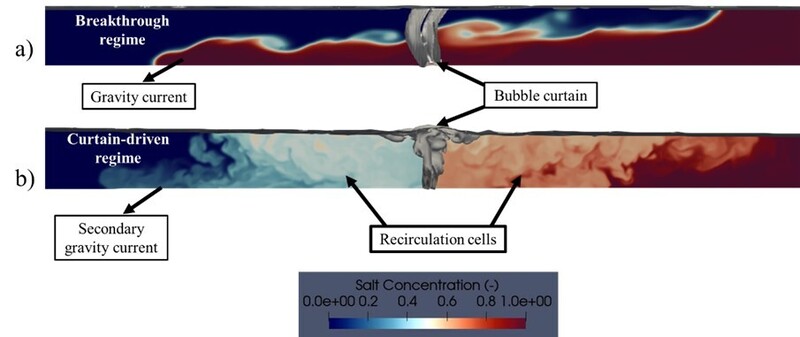Shravan K.R. Raaghav1*, Ronald Driessen1, Tom O’Mahoney2, Rob Uittenbogaard3, Herman J. H. Clercx1 and Matias Duran-Matute1
1 Fluids and Flows Group and J.M. Burgers Center for Fluid Dynamics, Department of Applied Physics, Eindhoven University of Technology, Eindhoven, The Netherlands; 2 Department of Hydraulics for Infrastructure and Industry, Hydraulic Engineering, Deltares, Delft, The Netherlands; 3 Hydro-Key BV, Haelen, The Netherlands
* Corresponding author: s.r.kaveripuram.ramasamy@tue.nl
Introduction
Increasing occurrence of seasonal droughts and rising sea water levels due to climate change result in enhanced saltwater intrusion in rivers and shipping locks. This poses a threat to the freshwater sources and enhances harbour siltation and maintenance due to changes in salinity. In a shipping lock, the opening of the lock gate results in an undesirable saltwater intrusion where the denser salty water flows underneath the lighter freshwater in the form of a gravity current. A common and reliable choice for mitigating saltwater intrusion is the use of bubble curtains. The vertical momentum of the water entrained by the bubble curtain disrupts the horizontal flow of the intruding gravity current. To ensure better design and robust field installation, it is imperative to further our understanding of the physics and operation of the bubble curtains. We performed computational fluid dynamics (CFD) simulations of bubble curtains in a lock-exchange configuration. Numerical simulations help overcome several limitations associated with experiments and field measurements such as access to 3D volumetric time-resolved velocity and salinity data, and flexibility to simulate a wide range of domain sizes.
Objective and Methods
This work aims to characterize and explain the flow resulting from the interaction between the bubble curtain and the gravity current for different values of the governing parameters. The overarching goal is to translate laboratory-scale results of bubble curtain effectiveness to field-scale locks.
We employ Euler-Euler large-eddy simulations to model the air-water bubbly upward flow, and we consider the Boussinesq approximation for the density differences due to salt concentration in the momentum equations. We use a prototypical lock-exchange setup, where the bubble curtain initially separates the fresh and salty side of a lock. The simulations cover a wide parameter range (lock depth – H , density difference – Δρ and air flow rate – qair) covering a wide range of Froude air number Frair = (gqair)1/3/(g'H)1/2 values, with g the gravitational acceleration and g' the reduced gravity. Frair represents the air flow inertia required to counteract the inertia of the gravity current. We additionally vary the aspect ratio of the lock AR = H/W (with W the width of the lock) for a broad range of lock sizes covering laboratory setups with AR ∼ 1 and real shipping locks with AR ∼ 0.25. Cases with AR ∼ 1 were validated using experimental data [1].
Results
The physical quantity of interest for evaluating the bubble curtain’s performance is the effectiveness, which characterizes the amount of salt water that is blocked by the curtain in comparison with the case without the curtain. We consider as a reference locks with AR ∼ 1. In this case, for Frair < 0.91, the inertia of the curtain is not enough to stop the gravity current in what is known as the breakthrough regime (see Figure 1a). For Frair > 0.91, the curtain-driven regime emerges, where the curtain’s inertia is strong enough to stop the gravity current, and the strong entrainment of water into the bubble curtain drives recirculation cells on each side of the curtain (see Figure 1b). We determined the typical velocity, length and time scales of these recirculation cells as a function of Frair. For the cases with field-scale AR, intriguing secondary flow patterns are observed in the curtain-driven regime. This result points to a difference between the flow in field-scale and laboratory-scale locks. We quantify the influence of these secondary flow patterns on the effectiveness and the scales of motion thereby shedding light on the applicability of laboratory-scale results to field-scale scenarios.

Figure 1: Contours of salt concentration fields obtained from simulations for a) breakthrough regime and b) curtain-driven regime
References
[1] Bacot, A., Frank, D., & Linden, P. F. (2022). Bubble curtains used as barriers across horizontal density stratifications. Journal of Fluid Mechanics, 941, A1.










